Car owners equip artificial lighting in the garage for convenient and safe operation. Competent selection and placement of light sources create comfortable conditions for entering the box and repairing the car.
- What to consider
- How to make a light in the garage with and without electricity
- Garage lighting requirements
- Garage Lighting Options
- Determination of lighting power
- LED lighting
- Instructions for lighting in the garage
- Drawing up a wiring diagram
- Choosing the location of light sources
- Calculating the number of lighting points
- Required tools and materials
- Phased work plan
- Inspection ditch lighting
- Helpful advice from an electrician
What to consider
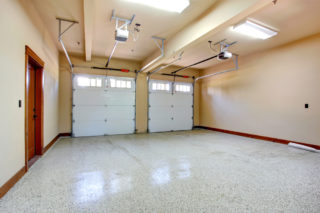
It is necessary to determine which lighting option is best for this garage. A plan is drawn up, taking into account the characteristics of the room, the characteristics of the lighting devices used, the preferences of the owner.
The final layout depends on the following factors:
- box area, ceiling height;
- availability of shelving, dedicated work areas;
- type of lamps;
- lamp characteristics;
- material and color of wall covering.
Don't underestimate the color of your walls. Light shades reflect light, increasing the illumination, while dark shades absorb light rays, darkening the garage space.
How to make a light in the garage with and without electricity
If the garage is connected to electrical networks, general and local lighting is made. They stretch wiring lines along the walls, ceiling, and also lead into the inspection ditch. Installation of electrical wiring requires compliance with safety rules.
The light in the garage without electricity is obtained from alternative sources. Autonomous lighting will help out the owner in the absence of a connection to the city power supply, as well as during temporary power outages.
The temporary lack of light can be compensated for by LED lamps or 12 V strips, which are connected to the battery. LEDs at minimum power give a luminous flux that is many times higher than that of other types of lamps. This allows you to illuminate the room for a long time and brightly from the capacity of one battery.
Make stationary or portable lighting. The battery is charged with a charger from the mains, an electric generator or from solar panels. Gasoline powered generators deliver more power but consume fuel.
Garage lighting requirements
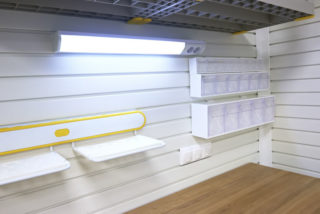
The garage serves the owner for household and repair needs, therefore, the lighting is equipped, taking into account the rules and regulations for car repair shops.
Garage lighting requirements:
- Uniform illumination of the space.
- Availability of separate light sources for work areas and shelving.
- Saving energy consumption during long-term operation.
- Insulation of lighting devices and electrical wiring from moisture and dust.
- Protection of luminaires from mechanical stress.
Lighting devices must be safe for humans. It is not allowed to install lamps with a shade made of thin glass, which, if broken, can injure.
Garage Lighting Options
Knowing the classification will help you determine which lighting arrangement is best in your garage. Lighting devices differ in the design and type of the installed lamp.
Types of light sources:
- Incandescent lamps have a low price, a small resource, low luminous efficiency - up to 15 lm / W. Unevenly scattered light, sensitive to voltage surges.
- Halogen lamps heat up during operation, have a luminous efficacy of up to 22 lm / W and an average lifespan. They fail in case of power surges, liquid, fat hitting the glass flask, therefore, they require installation in sealed caps.
- Fluorescent tubes are more economical - light output from 45 lm / W. They work unstably at voltage drops and temperatures below + 5 ℃. They contain mercury, which, when the flask loses its tightness, enters the environment, which is harmful to human health.
- LED panels, strips and lamps give out a luminous flux of 120 lm per 1 W of consumed electricity, which characterizes them as the most economical. The service life reaches 30 thousand hours.
In garages, overhead, pendant, recessed lamps are used, as well as devices on an adjustable bracket. The housing can be waterproof, dustproof, shockproof or with a protective grill.
Determination of lighting power
The total required power is calculated based on the required standard illumination of garages - 200 lux. It is equal to the illumination of an area of 1 m2 with a luminous flux of 200 lm. The required total luminous flux is determined by multiplying the standard by the garage area. For example, garage area S = 24 m2, then the required luminous flux:
L = S × 200 = 24 × 200 = 4800 lm.
By dividing the total luminous flux by the light output of the selected type of lamp, the required power of the light sources is calculated. For example, we chose incandescent lamps. Luminous efficiency Cн = 15 lm / W, then the total required power:
LED lamps have a luminous efficiency Cc = 120 lm / W, then:
The use of LED lamps significantly reduces the total consumption of lighting power at the same level of illumination.
With a garage ceiling height of more than 2.5 m, the actual luminous flux decreases, so the total power is corrected by multiplying by 1.5.
LED lighting
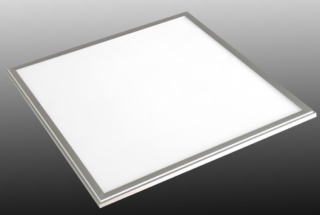
LEDs compare favorably with alternative light sources with increased luminous efficiency, long service life, and economical operation. Manufacturers have gradually lowered the price of LED devices, which have become available to most consumers. Installing LED lights in a garage will cost more than incandescent bulbs, but will pay off with energy savings and a long service life.
LED lighting can be mounted in the garage with your own hands. A popular option is to install waterproof LED panels with a built-in or external collimator. Such a lamp operates on a 220 V network, evenly scatters a luminous flux of 3000 lm at a power consumption of 30 W. The even distribution of light allows the luminaires to be installed on ceilings and walls below eye level.
A common type of light source is LED lamps with a threaded base. LED lamps for uniform lighting of the garage are installed on the ceiling equidistant from each other.
LED strips are mounted on the shelves, and an LED spotlight on an adjustable bracket is installed above the desktop, which will allow the light to be redirected to the desired place.
Instructions for lighting in the garage
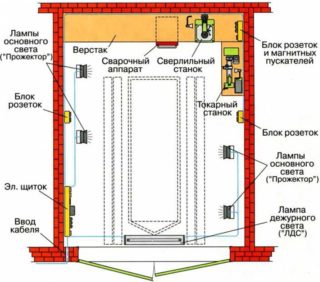
Lighting planning and installation is done in stages. Adherence to the suggested guidelines will prevent mistakes and the need to redo the layout in the future.
Drawing up a wiring diagram
They choose the method of laying the cable - open in the corrugation or closed in the grooves. Draw a plan of the garage with electrical wiring, taking into account the type of lighting fixtures.
The diagram indicates:
- Lines for laying electrical wires;
- Mounting place for the switchboard;
- Mounting points for switches, nodes, sockets;
- Tie points for general, zone lighting, additional equipment.
The drawing includes the planned equipment indicating the parameters, cable cross-section. It is convenient to purchase the necessary materials according to the exact scheme.
Choosing the location of light sources
With a small garage, one or two ceiling lights and light sources for workplaces are designed. Shelves require additional lighting.
For a large area, ceiling and side lighting fixtures are mounted. Local light is also needed. This arrangement eliminates shading from machinery and equipment.
A multi-level arrangement distributes light throughout the space most evenly. With this lighting option, the luminaires are placed on the ceiling and walls at a height of 0.4 m, 0.75 m, 1.8 m, respectively.
Low-lying lanterns are additionally covered with diffusing shades, protected by a grill. Lamps are selected with a low luminous flux to prevent glare.
Calculating the number of lighting points
The required number of lamps for the garage n is calculated by dividing the total required power P by the power of one lamp p:
An example of calculating the number of LED elements and incandescent lamps for a garage with an area of S = 24 m2 with the previously calculated parameters of the total powers: for LEDs, we take the power of one lamp p = 10 W, and for incandescent lamps p = 60 W.
Determine the required number of incandescent lamps:
Round n = 6.
Let's calculate the required number of LED lamps:
The 24 m2 garage is equipped with six 60 W incandescent lamps or four 10 W LED lamps. For halogen and luminescent sources, calculations are carried out in the same way.
Manufacturers produce lamps with different luminous efficacy parameters. Exact calculations are made based on factory data.
Required tools and materials
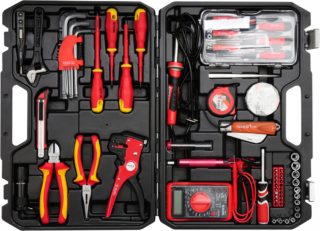
For marking, you will need a measuring and marking tool: tape measure, level, long ruler, pencil. Chasing the walls for electrical wiring is done with a chasing cutter, perforator or drill. Short grooves in soft material are hollowed out with a chisel and hammer. Installation is done with self-tapping screws, anchors, dowels, which are screwed in with a screwdriver.
For installation, you will need the estimated number of lamps, cables, switches, junction boxes, sockets, mounting brackets, corrugations. Distribution panel, meter, two residual current devices.
To work with wires, you will need pliers with wire cutters, a knife, a screwdriver, and electrical tape. To seal the grooves, use a putty and a spatula.
Phased work plan
Arrangement of garage lighting consists of preparatory and installation work carried out in stages:
- Preparatory work - drawing diagrams from the plan on the walls, grooving grooves for hidden wiring. If you plan to open installation, install cable channels or brackets for attaching the corrugation.
- Fix the switchboard with automatic machines and a counter.
- The cable is installed in the grooves, the channel, or led into the corrugation, which is fixed to the staples.
- Fix the nodal boxes, switches, sockets.
- Lighting fixtures are mounted on walls and ceilings.
- Connect the wiring to the terminals of lamps, junction boxes, sockets, switches.
- They install housings of switches and sockets, lampshades, covers of junction boxes.
- Check the circuit by connecting electricity. Eliminate flaws.
At the final stage, the grooves are closed, the cladding is fixed, the cable channels are closed.
Inspection ditch lighting
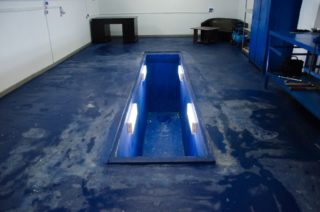
A person works in close proximity to lighting fixtures installed in a viewing ditch. The accumulation of dampness leads to electric leakage, which is dangerous for people. This increases the safety requirements for the arrangement of lighting in the observation ditch.
Stationary and portable lighting of the garage pit is performed by supplying a line with a voltage of 36 V and below. This voltage is obtained on a step-down transformer.
Sealed, moisture-resistant, dust-proof lamps, covered with shock-resistant shades, are installed in the pit.Additionally, they are covered with protective grilles.
To protect the luminaires from damage by falling objects, niches are made in the walls of the viewing ditch and devices are mounted in them on retractable brackets.
Helpful advice from an electrician
Electricians suggest installing garage lighting, guided by the following recommendations:
- Use a three-wire grounded wire for power cables. When the equipment is closed to the case, an RCD will work, preventing a person from being shocked.
- Connect a lantern for street entrance lighting through a motion sensor or photo relay. This will save energy consumption.
- Do not install fluorescent lighting in unheated garages. In cold weather, mercury lamps do not work properly.
- Provide emergency lighting in case of power outages. Keep a charged battery and some LED bulbs in holders in your garage. This will allow urgent work to be done independently of the grid.
- Use approved devices and materials for installation.
It is not difficult to equip lighting in the garage if you choose the right lamps, calculate their number and distribute them evenly around the perimeter.













